How to make localization for the Japanese market

As you may have heard, Shovel Knight finally crossed the ocean and reached Japan! We are very happy about this jump. We spent a lot of time to make localization interesting and smart. Wait, what is localization? This is the process of translating text and adapting the game to the local market. We work with excellent experts from 8-4 to ensure the highest quality localization. Today we want to talk about the most interesting changes that we made to the game so that the Japanese players really like it.
Story
But before we start ... let's take a little history lesson! Once upon a time localization of games was the Wild West. There were no standards or rules regarding what is acceptable for adaptation. Sometimes developers created absurd and full misprints translations. Sometimes developers put so much effort into creating a completely new series of games .

Bad Translation Bubble Bobble
')
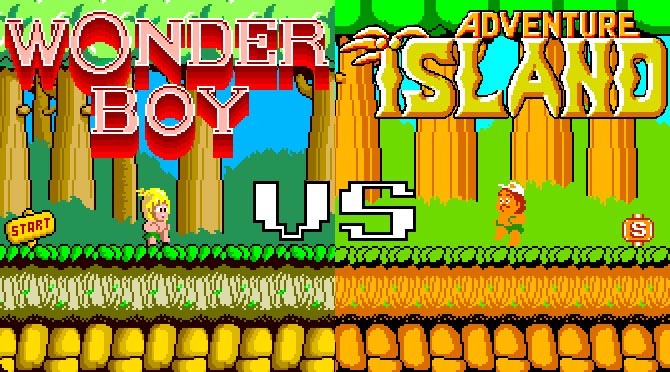
The Japanese game Wonder Boy, which became Adventure Island when porting to NES / Famicom. The game was divided into two independent series.
(Note: it turned out that Wonder Boy turned into Adventure Island when porting from arcade machines. We are confused, because often porting and localization are interrelated when transferring from Famicom to NES. Sorry for your mistake!)
Such inconsistencies have made many interesting changes to the localization of games. Developers with the release of each game were learning what exactly needs to be changed. In addition, due to the limitations of the NES, many changes were required when transferring games from the Japanese market. For example, there were problems with the complexity of fonts, technical limitations or game design, and this awareness came after the release of the game. We will cover only a small part of the examples of changes made to the games at that time, so that you can understand the reasons for the modifications we made at Shovel Knight for the Japanese market.
Before you read our story, better listen to a specialist, Clyde Mandelyn: http://legendsoflocalization.com/ . He writes awesome articles (and books!) About the most famous game localizations and changes made after the release of games in Japan.
The usual changes in the localization of Japanese games for the North American market
It is obvious that many small or large changes in texts occur during localization as a result of translation difficulties. But we are going to show how the graphics, sounds and gameplay of games that you could see in the NES / Famicom era have changed.
Graphics changes
Of course, usually one of the biggest changes in the game is the startup screen. Sometimes it is completely replaced, sometimes - just delete the Japanese text.


In those days, NES was often used to replace sprites. Often the logic was that players might not understand Japanese-specific sprites, such as food:

Or North American localizers could find that Japanese characters or sprites would not be attractive. Below is an example of a Power Blade, also known as Power Blazer in Japan. In her, the main character is made “cool” and not “cute.”

The truth known to everyone in the 80s: any game will sell if it has Arnold Schwarzenegger.
Sometimes these changes were made to make the gameplay more understandable:
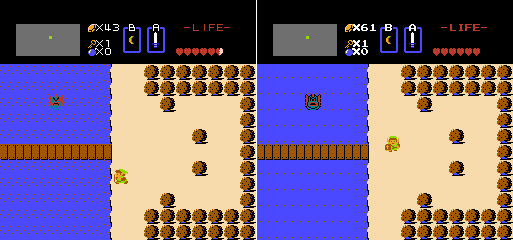
Wow! And I did not know that there is an enemy!
Super Mario Bros. 2 (known as Doki Doki Panic) in Japan is the case when Nintendo of America made significant changes to localize the game. This is a great example of how modifications were usually made at the time. They turned non-mario into mario!

In some cases, the developers decided to change the sprites so that they became animated! Below is an example of how the only change made gameplay objects really stand out:
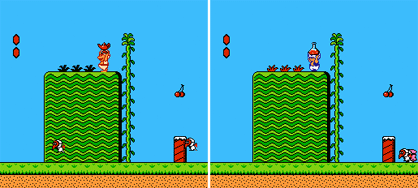
Maybe these plants can be pulled out?
Sprites could also become less or more complex. Or they simply changed to improve the Japanese version. Here is an example of this type of change from Mario 2:

Sometimes the animation changed due to differences in performance of the Famicom, NES or Famicom Disk System. Here is an animated sprite (actually a background tile that seems animated) from Zelda 2, which was removed from the NES version, because NES could not work with VRAM in the same way as FDS:
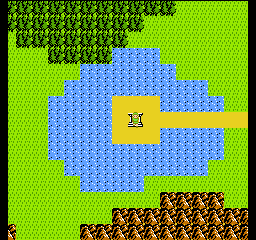
Wow, now I believe that it is really water!
Change fonts
In fonts often made a large number of changes. Creating a game in Japanese was difficult because the standard character set (kanji) was almost impossible to stick into the small amount of memory that NES could allocate. Kanji can contain thousands of characters (in a regular newspaper there may be more than 2500)! To get around this problem, sometimes in games a smaller set of kan characters was used (up to about 100 characters), or a much smaller set of English characters! English is common in Japan, so it did not make the games absolutely unplayable, as might be expected (especially considering the usually small amount of text in games for NES. Here are examples of text on the channel for NES / Famicom:
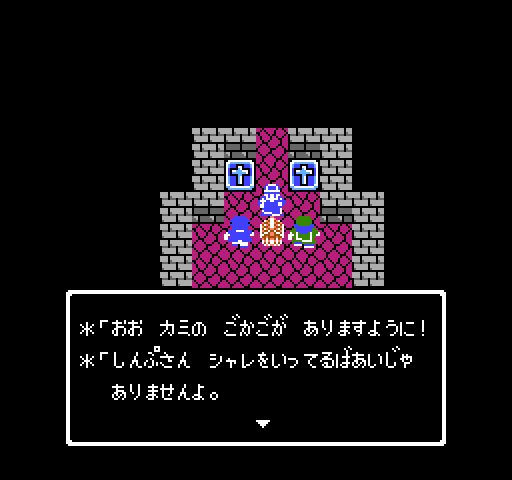
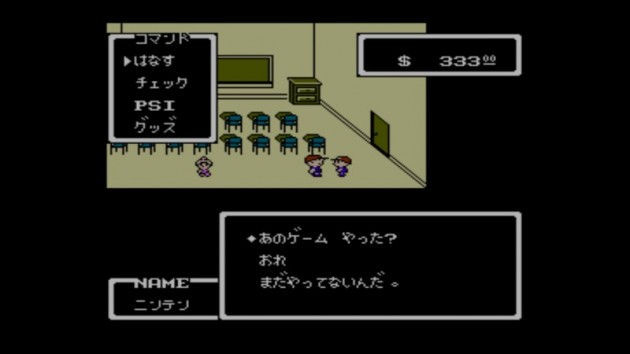
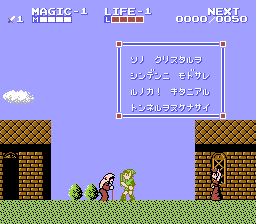
Here is an example of using English in the version of Zelda for Famicom:
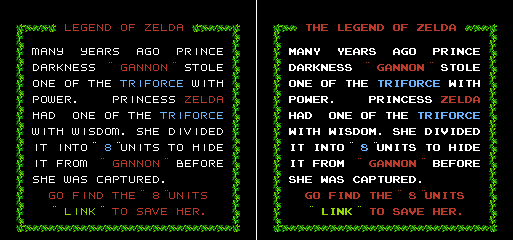
Notice the difference in fonts. The NES used the standard font 8 × 8, so the text for the North American market was changed to the usual one for the players. You may also notice that all the letters are in upper case! This reduced the number of characters required by half. The same principle is used in Shovel Knight.
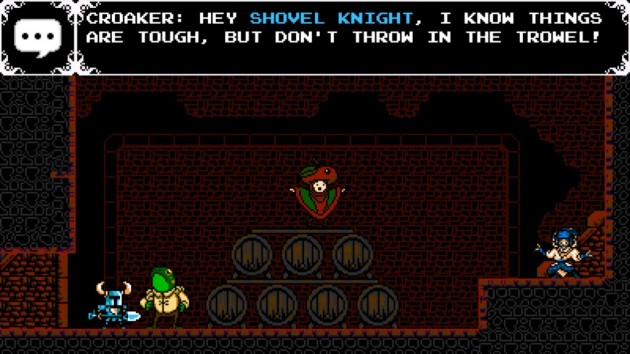
In cases where the readability of the text was very important, the developers invested more resources to create sophisticated text. Below is an example of how Final Fantasy for the NES overcame a lowercase barrier:
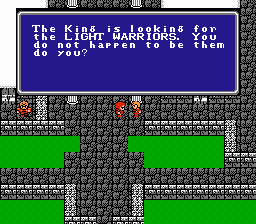
Oh, much nicer to the eye.
You can see how strange the letter in “g” looks in the word “king”. It became so due to the fact that in games for NES / Famicom there is only room for 8 × 8 pixels characters. The letter "g" violates these boundaries when properly written, so the symbol is simply placed higher. This is another reason why it is so difficult to display kanji on NES / Famicom. Because of the complexity of each character, it is almost impossible to draw them at 8 × 8 pixels. But there were cases when developers managed to pull out kanji on NES / Famicom. Look at Faxandu:
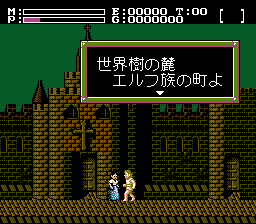
As you can see, the font is much larger than the standard size 8 × 8 due to the complexity of the kanji. In Faxanadu, the size is doubled: blocks of 16 × 16 pixels are used (where the size of the characters is 14 × 14). Developers had less freedom on Super Famicom / SNES, so kanji fonts often were 12 × 12 in size:
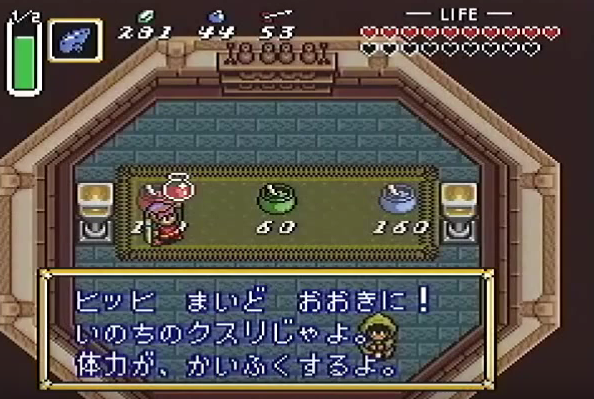
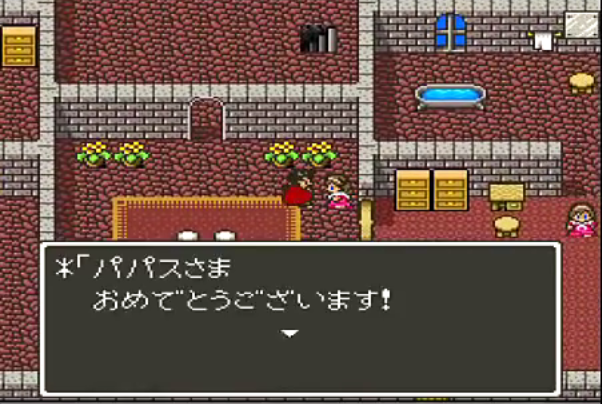
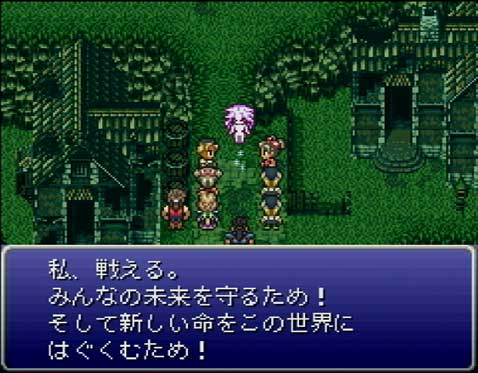
Sound
Not only the graphics changed, sometimes game localizers changed the sounds associated with gameplay objects.
They went even further and changed even musical compositions. Sometimes this was due to the difference in the hardware of the Famicom, NES and Famicom Disk System. Or, as we said earlier , this happened because of the difference in cartridge technology. Check out the differences between Castlevania 3 soundtracks in different versions:
Gameplay
Finally, sometimes the transition from Famicom to NES affected even the gameplay. The game could become easier or more difficult, the glitches removed from it due to differences in equipment, or the developers simply tried to make the game more interesting. Here are two rooms from Zelda, in which the authors decided to add bats!
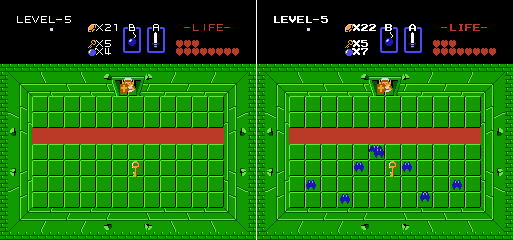
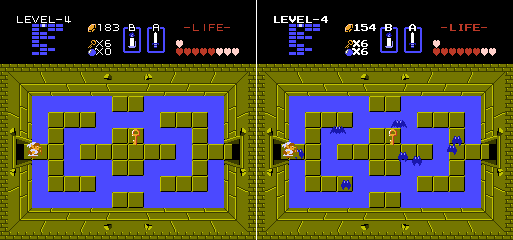
In addition, in the Zelda version for Famicom, opponents of Pols Voice could be defeated by sound, but there was no microphone in the NES controller, so they were defeated by arrows:
Shovel Knight localization changes
Therefore, when we started to localize Shovel Knight, we wanted to recreate some funny differences between regional versions. We even tried to perform the process of "reverse" localization. This meant that we wondered what the Shovel Knight game would look like if it had first been released in Japan. However, we had rules regarding changes:
- We wanted to preserve the integrity of the gameplay.
- We didn’t need significant changes that would make the players regret that they didn’t play the original version.
- We did not want to do what is traditionally considered a poor localization.
For us, this meant no typos or bad English, anything that could reduce the quality of the game. In addition, we did not want to change the game too much! And finally, the localization level should be excellent by modern standards. But we wanted to add some interesting details. Therefore, we made minor changes, which as a result were significant differences!
Change graphics
The startup screen obviously remained the same. We wanted to correspond to what could have been expected from the Japanese game of that era, that is, the Japanese text, along with the English logo:

After that we made changes to static sprites. The picture below shows that when the level of health increases, Gastronomer can sometimes randomly submit onigiri (rice bun).
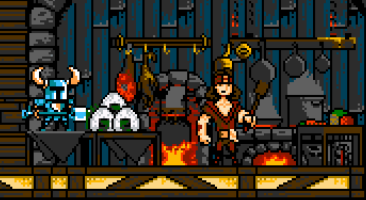
In addition, the Midas coin now has a hole, which makes it look like some Japanese coins:
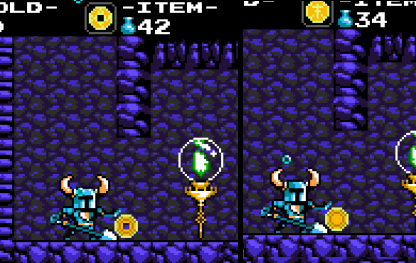
Changed the design of the statues in the Hall of Champions.
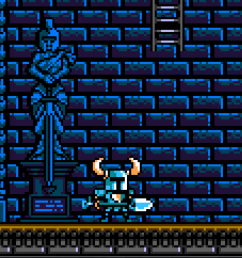
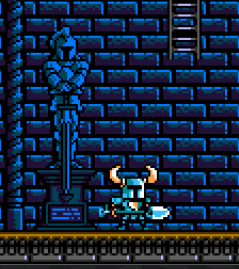
We also made minor color changes. In particular, the Wizzem and Iron Knight palette types are changed as follows:

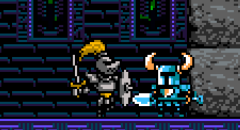
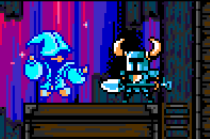
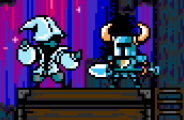
Recent changes to static sprites made processing portraits of characters Reize, Baz, Polar Knight and The Enchantress. We tried to make their art style more anime.






After that, we decided it was time to make some static sprites animated so that they showed the full power of Famicom! First, we decided to animate the grass in the Plains episode:
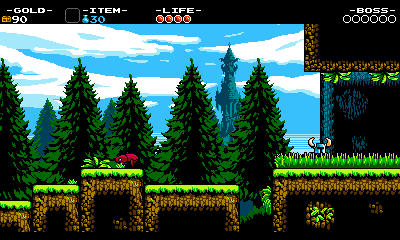
For dragons (green and blue), we first created sprites with a lot of animation frames of their flight, but decided to trim them because they didn’t look like sprites with NES. But we returned the animation in the Japanese version!


We changed the design of the fountain in the village and animated it with streams of water.
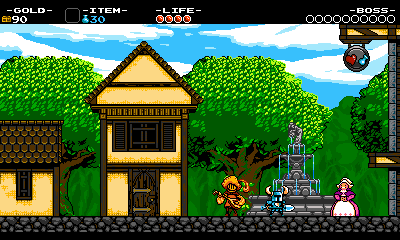

And the last graphic change: a slevel near the campfire Shovel Knight blows bubbles with his nose.

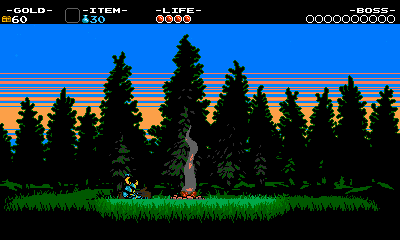
Change fonts
The font needed a clever solution. We wanted to use kana symbols, because they are more characteristic of the era and the limitations of the NES. On the other hand, most Japanese players would rather play a kanji game. Kanji can be considered a nostalgic return to retro style, and it was also widely used on the Super Famicom. However, the kanji would require reworking all the text fields in the game, because we created menus, dialog boxes, etc. under 8 × 8 font characters. Therefore, obviously the use of the kana would be the simplest way. And after much deliberation ... we decided to make both fonts!
The game was officially translated into both alphabets and supported switching between them on the fly:
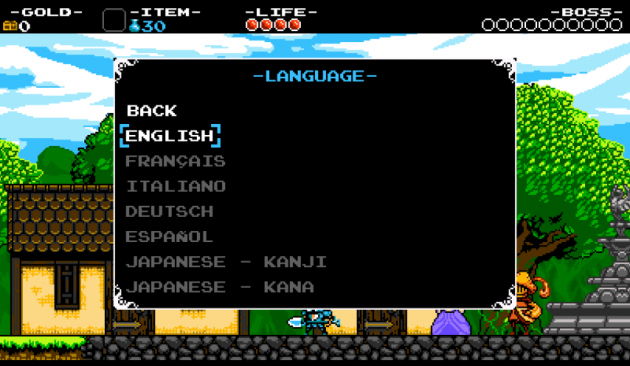
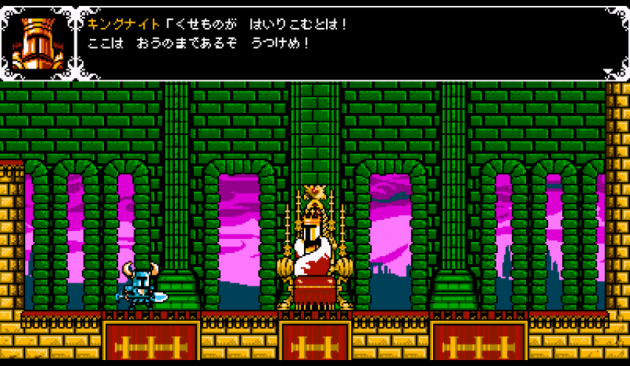
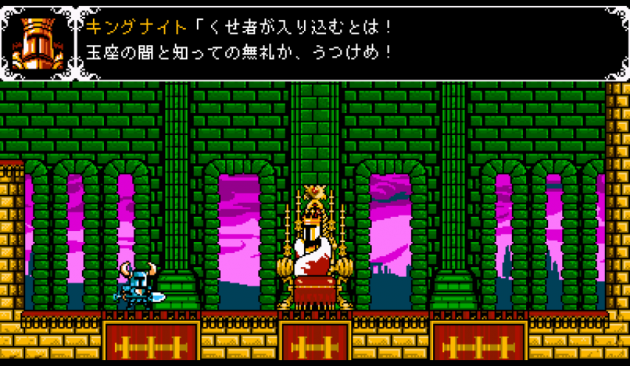
As you can see, we have selected a size of 12 × 12 pixels for a kanji font. This allowed us to get closer to the fonts on the Super Famicom.
Notice also that we left the interface text in English. We thought that at that time it was usual to use English in the interface, so we decided to stick with it:
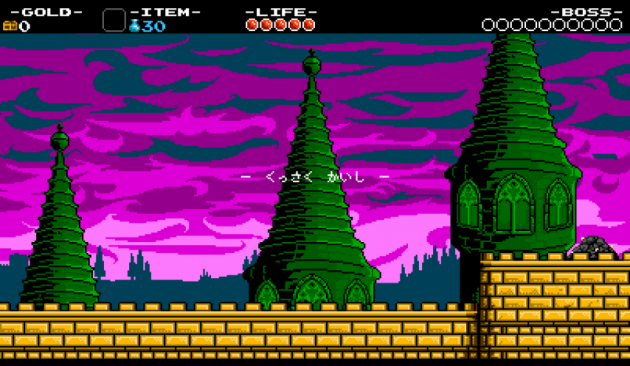
Change sounds
Here we have changed not so much. We have already gone dear Famicom in terms of music and added a VR6 chip . Therefore, we decided to change just a few sounds:
- The sounds of Gryphon's death and Bubble Dragon's death swapped places.
- The Fire Wizard (and Shovel Knight's fire rod) uses the sound of fire, not magic.
- When fairies bite a character, other sounds are played.
Additional cheat codes!
But we did not stop at that! We decided to add some more details. Remember the X & BUTT cheat code? (Note: he replaces some words in Butt conversations, i.e. “ass.”) Unfortunately, “ass” is not the funniest word in Japan, so we came up with another replacement pattern. Along with the replacement of the text, the cheat code also includes two graphic replacements, which in the main game seemed to us too much.
Carrots are replaced by Japanese radish daikon:

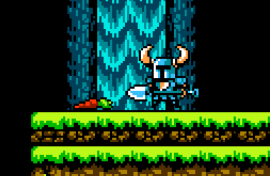
Gold coins become vertical and more like coban coins.

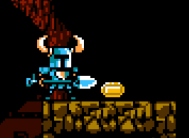
In addition, we made it so that this special Japanese cheat includes localization changes in all languages. But if you do not want to use the cheat code, you can switch to Japanese at any time to see all the changes.
thank
We hope you enjoyed this short excursion into the history of our Japanese localization. Translation of the game is a difficult job , and we hope that as many people as possible will see how much love is invested in the release of each game. You should try to play when the changes for the Japanese market come out!
Source: https://habr.com/ru/post/320322/
All Articles